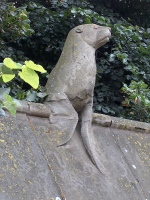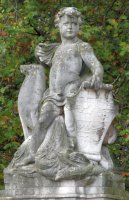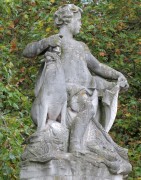
The seal is not the most obvious animal to choose to make a sculpture of, and I can think of just a few statues of seals from Victorian or Edwardian times. The first is one of those beasts to be found on the wall known as the ‘Animal Wall’ of Cardiff Castle in Wales, which bears a series of stone animals on its parapet. A picture is shown above. A very simple rendition, it nevertheless captures something of the jaunty pose and manner of a seal. The sculptor was Thomas Nicholls, working to the design of the arts and crafts architect and artist William Burges, his main employer, and the date is from the late 1880s.

 Two views of the Canadian Seal, Victoria Memorial.
Two views of the Canadian Seal, Victoria Memorial.
The second seal statue is from a group on one of the two posts to the Canada Gate of the Victoria Memorial. The animal makes a nice allegory for Canada, which is not so frequently featured in British sculpture. The seal stands at full height on a net filled with fish, and has a fish in its mouth. Again, the sculptor has caught the particular stance of the live animal.
A third significant seal sculpture is the seal or sea lion eating a fish which forms a part of the excellent collection of sculpture which makes up the Victoria Rooms Fountain in Bristol. The blubberiness around the neck, the tiny ears, the wetness of the animal are what combine in this statue to give the essence of sealhood. A much lesser animal is that in Bermondsey on the surviving entrance to the Alaska Factory - for picture, see bottom of this page.
The seal head in architectural sculpture is not entirely unknown; above is a picture of a sea lion head, with great tusks, forming the capital of a pillar. If you want more on pillar decoration, see this page.
Visits to this page from 1 Apr 2013: 6,220
Fish sculpture // Animal sculpture // Allegorical sculpture